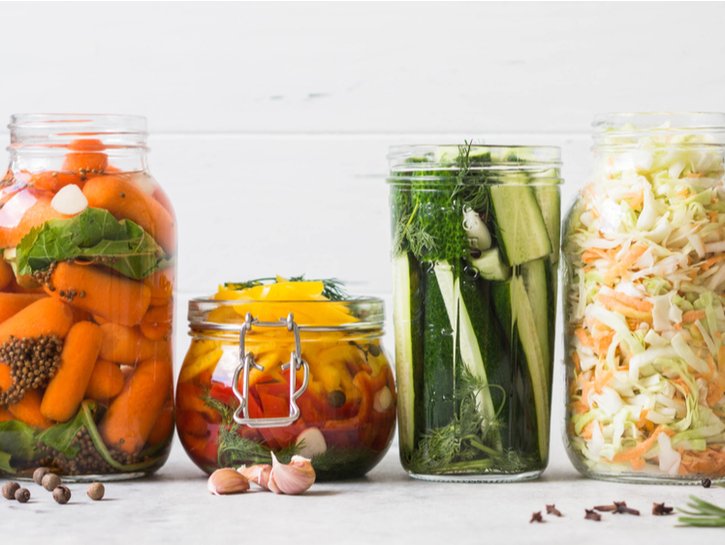The quickest, tastiest, easiest way to prepare vegetables for last-minute meals doesn’t involve your microwave. Instead, it consists of a jar brimming with brightly colored pickled vegetables bursting with mouthwatering flavors from the spring and summer seasons.
Bold, crisp, and tangy, pickled vegetables are a simple side dish that can add extra pop and pizzaz to just about any dish. Piled high on a juicy burger, tossed in a spring salad, to a simple, tasty side dish, pickled vegetables are always a welcomed healthy treat. And, the best part? It’s possible to have pickled vegetables ready in less than an hour.
Just about any vegetable you can find in your garden or you stumble upon at your local farmer’s market is able to be pickled.
Similarly, all pickled vegetables begin their pickled journey in a brine-y mixture of salt, sugar, vinegar, and water. A blend of unique spices to make it your own can be added before allowing the vegetable time to pickle. Discover the simple way to pickle vegetables for a refreshing new way to enjoy summer’s bounty.
Quick Pickling Versus Canned Pickling

Quick pickling or refrigerator pickling is the fastest and easiest way to enjoy pickled vegetables of any kind. Quick pickling requires customizable brining and marinating, but only allows for short-term shortage, about a month if they’ve been prepared and stored correctly.
Quick pickling is all the rage for its snappy process. Quick pickle hobbyists won’t have to worry about special equipment, careful canning skills, extra prep, or worse, botulism. Botulism is an illness caused by a bacteria toxin and improper home canning, creating the ideal environment to grow this dangerous bacteria.
The ease and convenience of quick pickling allow a new generation to dip their toes into the pickling scene without too much fuss while creating a new and exciting way to use up extra produce.
On the other hand, canning is much more involved than quick pickling, yet it allows for long-term storage, about one year. Canning is a method of preserving, processing, and sealing fresh vegetables or fruits in an airtight jar.
After jars are packed, they are often placed in what’s known as a water bath, where the jars are boiled for an allotted amount of time, killing off any harmful bacteria. Canning can be intimidating and time-consuming with inflexible steps making quick pickling much more appealing than traditional pickling.
How to Quick Pickle Vegetables

Enjoy the flavors of the undeniably delicious brine-y flavor of pickled vegetables without the hassle of canning by quick pickling.
Ingredients
- 5-6 cups of sliced vegetables of your choice
- 2 cups water
- 2 cups vinegar (white, red wine, rice wine, apple cider)
- 2 tablespoons kosher salt (iodized salt can cause your pickled veggies to turn a dark color.)
- 4 tablespoons sugar
- assortment of fresh herbs and spices
Materials
- small pot
- two-quart size mason jars
Directions
- Before you begin, wash your mason jars with warm, soapy water, then rinse well. Next, warm your glass jars with hot water to reduce the likelihood that the glass will shatter when the brine is poured inside.
- Next, carefully wash and dry your produce. Choose how you’ll slice your vegetables to be placed inside the jars. Next, pack your jars with the sliced vegetables, along with your chosen fresh herbs and spices.
- In a small pot, bring the water, vinegar, kosher salt, and sugar to a boil. Next, carefully pour the hot brine over the veggies in both jars so they’re completely submerged, leaving at least a half-inch of room between the liquid and lid.
- Then allow the jars to cool to room temperature. Once the jars are room temperature, about an hour, seal them shut with the lid and transfer them to the refrigerator. Allow to quick pickle for at least an hour to overnight for best results. Enjoy your quick-pickled vegetables within one month. Makes two quart-sized jars of quick-pickled vegetables.
What Are the Best Vegetables to Quick Pickle?

Any vegetable can be pickled. Yet, the best vegetables are the freshest that come straight from the garden, the farmer’s market, or the local grocer.
Steer clear of vegetables that are bruised, soft, or that have been hanging out in your refrigerator crisper for longer than you’d like to admit. Your older veggies are excellent candidates for stews, soups, or casseroles.
Any vegetable is a likely nominee for a quick pickle. Cucumbers are undoubtedly the most popular go-to choice, but there are many other appealing options for pickling enthusiasts to explore. When the neighbors kindly decline any more yellow summer squash donations, you can start quick pickling summer squash for an easy summer side dish always ready to go.
There are pickled red onions for piling high on grilled burgers. Serve up with bloody marys with pickled asparagus. From beets to green beans, radishes, mushrooms, carrots, and cherry tomatoes, the possibilities of which vegetables to choose to be quick pickled are endless.
Discover Easy Ways To Flavor Quick Pickles

There is no right or wrong way to flavor quick pickles. But there are a few fresh herbs and spices that are familiar favorites in the quick pickling world for adding vibrant flavor to any meal.
Herbs
- thyme, dill, bay leaf, or rosemary
Whole Spices
- black peppercorns, coriander, or mustard seeds
Other Flavorings
- crushed garlic, red pepper flakes, cumin, star anise, or allspice
Flavor Combo Ideas

Summer Squash and Zucchini Pickle
3 cloves of garlic
3 bay leaves
6 whole peppercorns
1/4 cup chopped fresh parsley
1/4 cup chopped fresh dill
Quick Red Onion Pickle
When preparing quick pickled red onions, you may use a combination of vinegar such as white vinegar and apple cider vinegar. Honey or maple syrup can be used in place of regular sugar for deeper flavor. Additionally, 1/4 teaspoon red pepper flakes can be added for an extra bite.
